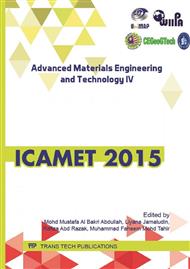p.487
p.491
p.495
p.499
p.503
p.509
p.514
p.519
p.524
Printing of Silk Fabric with Reactive Dye Using Flour of Wild Taro Corm as a Resist Printing Paste
Abstract:
The present study was undertaken to use flour of wild taro (Colocasia Esculenta (L.) Schott) as a resist printing paste for silk fabric and using reactive dye as a dyestuffs. The K/S values, whiteness index and sharpness of printed silk fabric were studied. The washing, water, perspiration, light and rubbing fastness of the printed fabric was also evaluated. From the present work it can be concluded that the pattern at resist printing area of silk fabrics show sharpness and whiteness. Colour fastness to water and perspiration were ranging between poor to fair level. Printed fabric exhibited fair to good level in washing, rubbing and light fastness. The advantages of this product are environmental friendly that is non-toxic fumes; production cost is lower, instance application and creative process enhancement in textile production.
Info:
Periodical:
Pages:
503-506
Citation:
Online since:
May 2016
Keywords:
Price:
Сopyright:
© 2016 Trans Tech Publications Ltd. All Rights Reserved
Share:
Citation:


